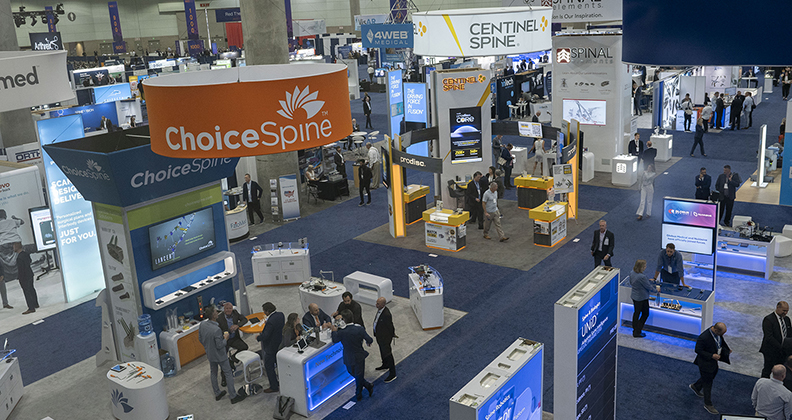
Thousands of industry leaders, researchers and top surgeons from around the world will gather in Chicago next week for the 39th annual meeting of the North American Spine Society (NASS). We’ll be among the crowd to see firsthand the innovative technologies that are advancing spine surgery and patient outcomes. Here are a few of the companies that will showcase new and exciting solutions that we’re looking forward to checking out.
Johnson & Johnson MedTech recently launched VELYS SPINE, which was developed in collaboration with eCential Robotics and received FDA 510(k) clearance for planning and instrumenting spinal fusion procedures in the cervical, thoracolumbar and sacroiliac spine. The system features standalone navigation and an active robotics platform that provide surgeons with flexibility in their surgical approach and planning.
J&J MedTech recognized the need to develop enabling technology platforms to compete at the top of the spine market and wants to give surgeons more control in performing complex procedures. At NASS, the company will provide attendees with hands-on demonstrations of the new technology.
Stryker’s Spine Guidance 5 Software featuring Copilot technology integrates smart-powered instruments into Stryker’s ecosystem to support surgeons as they perform bone resection, pedicle preparation and screw delivery. Smart Zones for bone resection within the system provide auditory and sensory feedback when surgeons approach the planned anatomical boundaries with a high-speed drill. The Copilot Smart Driver also stops surgeons when they reach the pre-planned depth. Both features help surgeons prepare and place pedicle screws more precisely and safely.
Stryker reps said the platform represents the beginning of the company’s enabling technology pipeline in spine. It’s also part of the big-picture goals of Stryker, according to CEO Kevin Lobo, who said gaps in its spine-based enabling technology offerings have kept that business from growing above the market rate in recent years.
Medtronic will showcase the AiBLE digital ecosystem, which includes the StealthStation S8 surgical navigation system that allows surgeons to track the locations of surgical instruments during procedures and the Mazor robotic guidance platform that employs automatic anatomy recognition capabilities to let surgeons plan for the accurate placement of cages and screws. Medtronic said the AiBLE system helped drive the company’s high single-digit growth and outperformance of the spine market. In the company’s fiscal 2024, it generated $3.38 billion in orthopedic sales, 6.8% more than the previous year.
Arthrex recognized an opportunity to improve upon open spine procedures by applying its expertise to develop endoscopic, tissue-sparing approaches. Endoscopic surgery is relatively new to the spine segment and Arthrex wants to expand its application to complex cases as surgeons become more comfortable with the technique and performing procedures through smaller incisions.
Zak Kemp, Arthrex’s Director of Global Spine, said the company’s cameras and scopes are helping to drive the adoption of endoscopic surgical techniques, which allow surgeons to operate in a bloodless field with enhanced visualization and precision.
The company’s initial launch of its endoscopic product line is focused on the U.S. spine market and will expand globally in the coming years.
ATEC launched EOS Insight, an AI-driven and cloud-based software platform that aims to relieve the burden of surgical planning for surgeons. ATEC CEO Pat Miles said most surgeons don’t prepare for surgeries with traditional planning platforms because the technology is inefficient to use and provides little value in terms of intraoperative accuracy.
ATEC hopes to change that calculus with EOS Insight’s capabilities, which include implant alignment assessment, 3D surgical planning and simulation, patient-specific rods, intraoperative reconciliation and postoperative analytics.
The successful launch of EOS Insight is expected to help ATEC remain one of the top-performing companies in the spine segment. ATEC generated $284.1 million in orthopedic sales in the first half of this year, 25.7% more than the first half of last year.
Orthobond received an FDA De Novo marketing request for the use of Ostaguard, a proprietary antibacterial surface treatment with an initial application in the field of spinal implants. It was the first granting of a De Novo submission for a non-eluting coating designed to actively kill bacteria on the surface of medical devices.
Orthobond’s technology creates a covalently bound nanosurface that is designed to kill bacteria, viruses and fungi on implants but is safe for human contact. It is applied during the manufacturing process before packaging and sterilization.
Ostaguard has been shown in clinical studies to be highly effective in killing multiple strains of bacteria that could contact an implant in the operating room. It fills a need for an easy-to-implement antibacterial coating in the design of orthopedic implants.
Orthobond’s leadership believes the surface coating has the potential to be the standard of care for implantable devices to protect patients from pathogens. The company has numerous devices treated with the technology in various stages of the regulatory process, including joint replacement and sports medicine implants.
There will be plenty more to see while we’re walking the exhibit hall at NASS. Reach out if you’d like to meet up at the conference (we’ll be at booth 2914) and share new products or solutions that you’d like us to see while we’re in the Windy City.
DC
Dan Cook is a Senior Editor at ORTHOWORLD. He develops content focused on important industry trends, top thought leaders and innovative technologies.




